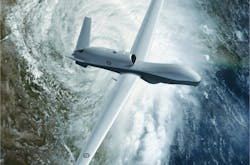Raytheon to provide multispectral targeting sensors for Navy Triton unmanned surveillance aircraft
CRANE, Ind. – U.S. Navy maritime surveillance experts are ordering multispectral targeting sensors for the Northrop-Grumman MQ-4C Triton long-range unmanned aerial vehicle (UAV) for maritime patrol applications.
Officials of the Naval Surface Warfare Center Crane Division in Crane, Ind., announced a $23.2 million order late last month to the Raytheon Technologies Corp. Intelligence & Space segment in McKinney, Texas, for AN/DAS-3 Multispectral Targeting System (MTS) sensors for the Triton maritime surveillance UAV.
The AN/DAS-4 is the latest variant of the Raytheon MTS family of electro-optical sensors, and incorporates greater fire control and target location accuracy for precise targeting coordinates, Raytheon officials say. The Triton is a maritime version of the Northrop Grumman RQ-4 Global Hawk.
The Raytheon MST provides intelligence, surveillance, and reconnaissance (ISR), detection, identification, and targeting capability in day and nighttime operations on manned and unmanned aircraft.
MTS sensors provide detailed intelligence data from the visual and infrared spectra. The new AN/DAS-4 MTS variant enables mission commanders to use high-definition data from an airborne tactical sensor to identify and engage targets with much greater accuracy, Raytheon officials say.
The DAS-4 includes four high-definition cameras covering five spectral bands; a three-color diode pump laser designator and rangefinder; laser spot search and track capability; automated sensor and laser bore sight alignment; three-mode target tracker; and built-in provisions for future growth.
This advanced electro-optical and infrared (EO/IR) system provides tracking and laser designation for the Griffin and Paveway missiles, as well as all tri-service and NATO laser-guided munitions. MTS sensors offer several fields of view, electronic zoom, and multimode video tracking.
Multispectral sensors divide images and video into several light wavelengths -- typically three to 15 spectral bands -- across the electromagnetic spectrum, including light from frequencies beyond the visible light range such as infrared and ultra-violet.
Dividing images into several different wavelengths enables the sensor to extract additional information the human eye fails to capture with its receptors for red, green and blue.
The L3Harris Technologies Advanced Laser Systems Technology segment in Orlando, Fla., is providing the eye-safe laser rangefinders for the Raytheon MTS.
Raytheon has delivered more than 3,000 MTS sensors to U.S. and international armed forces and integrated 44 variants on more than 20 manned helicopters, fixed-wing aircraft, and UAVs.
On this order Raytheon will do the work in McKinney, Texas, and should be finished by March 2023. For more information contact Raytheon Intelligence & Space online at www.rtx.com/our-company/our-businesses/ris, or the Naval Surface Warfare Center-Crane at www.navsea.navy.mil/Home/Warfare-Centers/NSWC-Crane.

John Keller | Editor-in-Chief
John Keller is the Editor-in-Chief, Military & Aerospace Electronics Magazine--provides extensive coverage and analysis of enabling electronics and optoelectronic technologies in military, space and commercial aviation applications. John has been a member of the Military & Aerospace Electronics staff since 1989 and chief editor since 1995.

